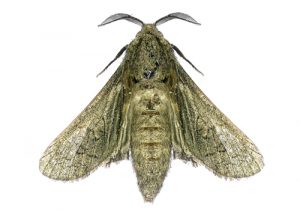Why Do Moths Fly to Lights?
By Chris Williams on September 19, 2011.
Q. My son is doing a science fair project on night-flying moths. Why do moths and other insects fly to lights anyway? It doesn’t make much sense since they usually end up beating against the bulb and frying themselves! Is there an advantage?
A. Well, there is an advantage in “going to the light” for some insects and spiders since they can find insect prey there. But for those insects, like moths, that are the prey, it doesn’t seem like such a good idea.
Some say that moths mistake our modern-day bright lights for the moon, by which they navigate, and spiral upward and upward towards the light, trapped in a useless orbit. Instead of being oriented to the moon, the moth becomes disoriented. Others theorize that nocturnal insects spend their days hidden in cracks and crevices, so when night comes, they head for the nearest light to find the exit; they think they are leaving a cave.
 Some insects are attracted to light only at certain times of day or certain times in their life cycle and avoid light at other times. Some pests that spend the winter hibernating in our homes, like cluster flies and Asian lady beetles, avoid light during the winter and hide in cracks and crevices. But when spring comes, they are drawn to the light of windows, trying to find a way back outside to find a mate.
Some insects are attracted to light only at certain times of day or certain times in their life cycle and avoid light at other times. Some pests that spend the winter hibernating in our homes, like cluster flies and Asian lady beetles, avoid light during the winter and hide in cracks and crevices. But when spring comes, they are drawn to the light of windows, trying to find a way back outside to find a mate.
Other insects, besides moths, are attracted to lights, too. Midges, mosquitoes, ground beetles, June beetles, wood cockroaches, crickets, mayflies, lacewings, and European hornets are just a few of the insects that can collect around lights. That’s why insect light traps can capture flying insects. It’s also why backyard bug zappers are not very effective at controlling mosquitoes: because they capture mostly midges and other insects, and their bright light draws in insects that weren’t even in the area.
Unfortunately, insects’ attraction to light is one reason why we end up with pests in our homes. They will fly (or crawl) to outside lights, porch lights, or even bright indoor lights shining through a window. When spiders and other predators realize that your porch is a good place to find food, they establish there as well. Besides the mess that they can make of your entry with droppings and carcasses, some of these pests are going to find their way indoors.
There are measures that can be taken to reduce the number of insects attracted to outdoor lights. These include changing the type and intensity of bulbs, shielding the bulbs so they project outward rather than downward, moving lights that are mounted directly over doorways so that they shine onto the doorways from a distance instead, even turning lights on later in the evening to avoid early evening swarms of midges.
For the record, not all moths are attracted to light. The clothes moths, for example, avoid light and hide in dark places instead. That makes sense for the clothes moth since it lives in dark closets, boxes, and cedar chests where you store your woolens. So there isn’t a really good, single reason why moths fly to lights. Maybe your son can come up with the answer!